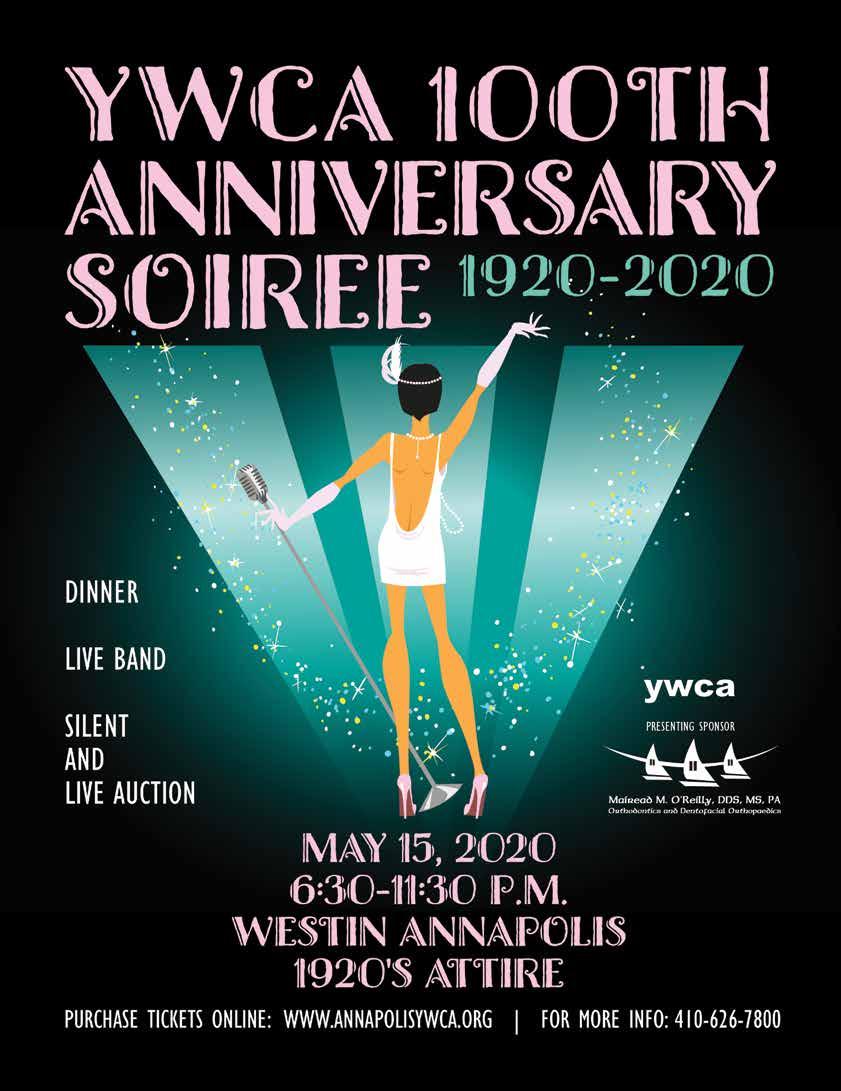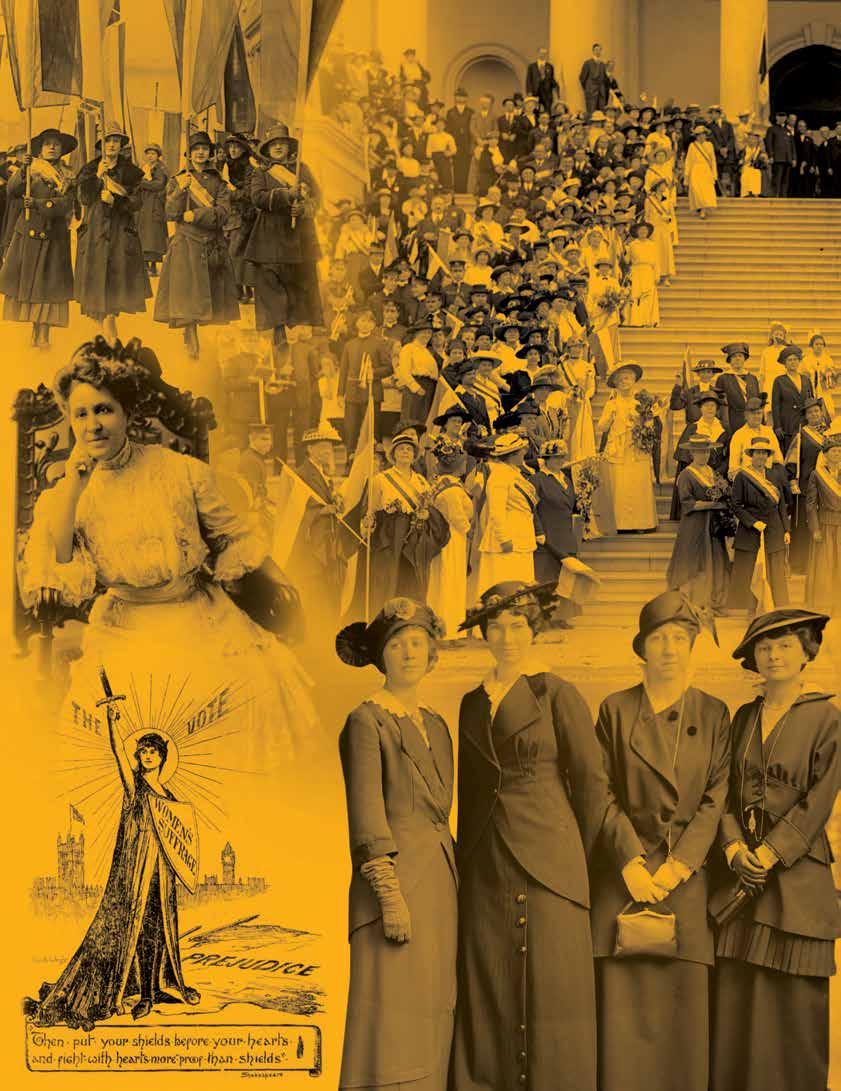
17 minute read
Year of the Woman
2PART
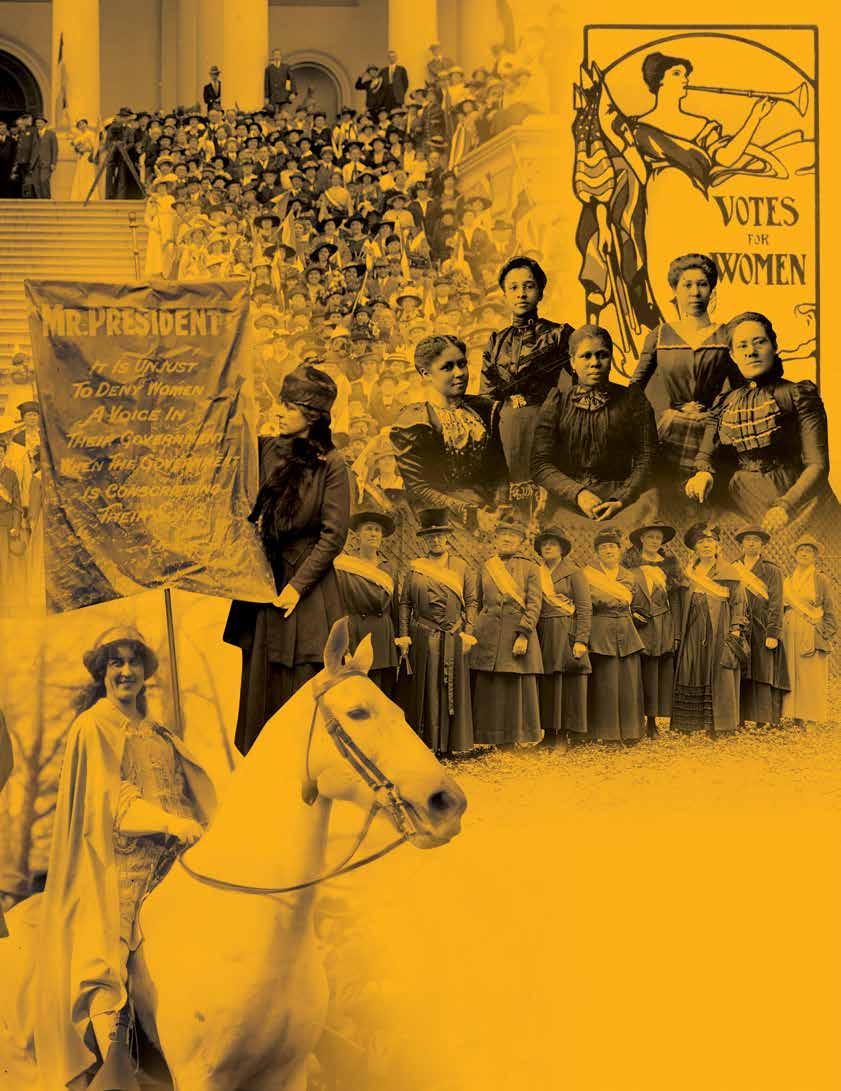
What’s Up? Media has teamed up with many passionate women from the community to commemorate the centennial of women’s suffrage. Year of the Woman is a nonprofit organization devoted to celebrating how far we’ve come while envisioning what’s next. Through this endeavor, we hope to create a platform in which the community as a whole can join the conversation, discussing the changes that have taken place while envisioning the next 100 years and the work yet to be done. In this upcoming year, the What’s Up? Media publications will feature a series of stories themed around women’s suffrage. Throughout 2020, Year of the Woman hopes to sponsor a series of speakers, events, films, and book clubs. We also plan to work closely with local schools so that children and young adults—who can’t even imagine a world where women had no rights—can learn the importance of this monumental time in history. We hope that you can join us in bringing awareness to the 100th anniversary of women receiving the right to vote!
Petition to Congress from Susan B. Anthony, Matilda Joselyn Gage, and Elizabeth Cady Stanton of the National Woman Suffrage Association. The petition was referred to the Committee on the Judiciary on January 20, 1873.
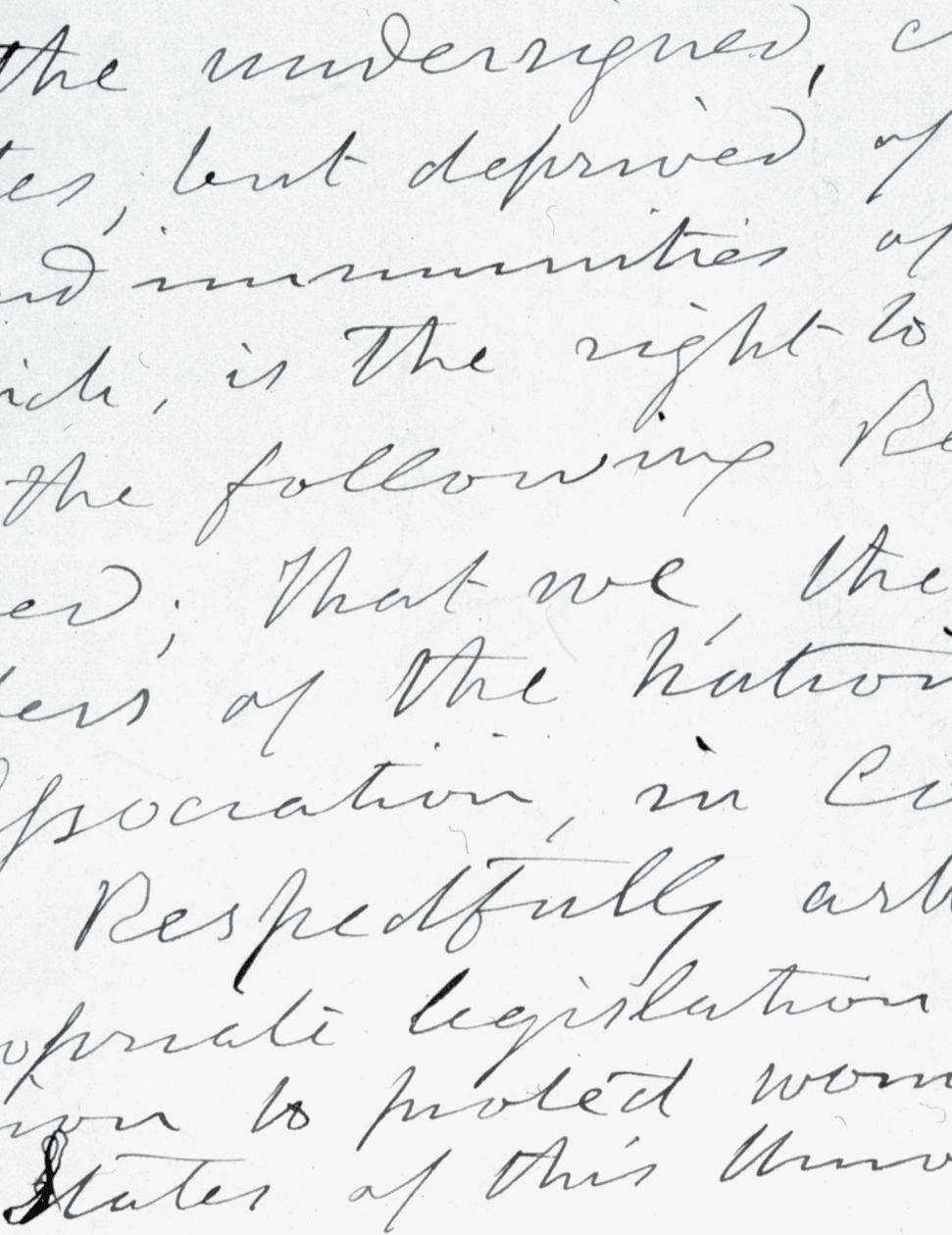
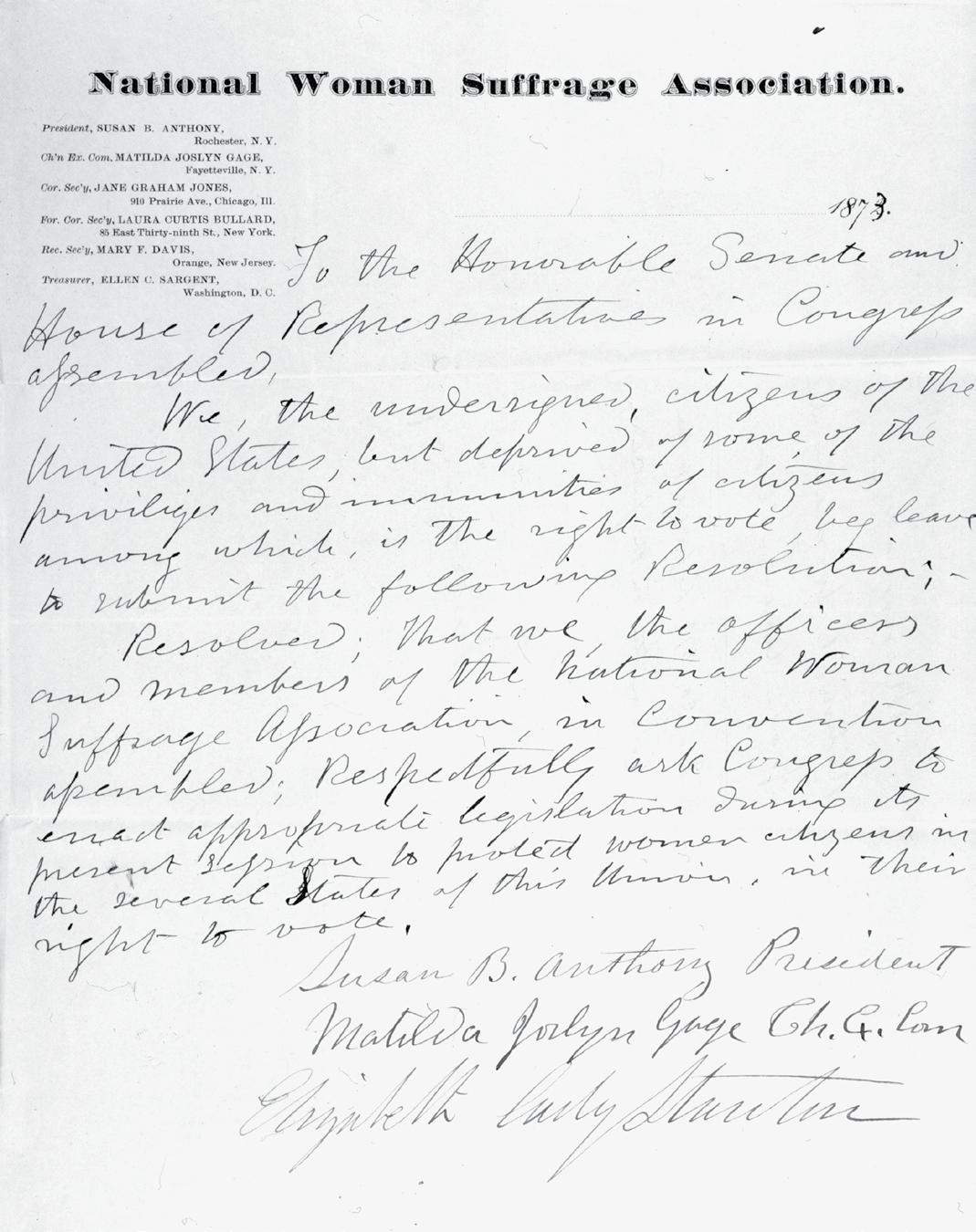
Manifesting Their Destiny
In the 1800s, a movement
is afoot in the United
States, as the call for
women’s rights and
suffrage intensifies
By Ellen Moyer
During the first half of the nineteenth century, the United States was experiencing its first intellectual movement inspired by Ralph Waldo Emerson and Henry David Thoreau, who believed in the inherent goodness of people and nature, and the power of individuals when they were self-reliant and independent. Louisa May Alcott and Margaret Fuller joined in the discussions of the group (identified in history as transcendentalists) and contributed written articles to the “club’s” publication The Dial. In 1843, Fuller’s publication of “The Great Lawsuit” compared a woman’s position in society to that of slaves. The book implored women to seek independence in their everyday lives and for men to cease dominating holds over women. It established women’s rights as a civil and moral issue, and attacked the hypocrisy of men as the greatest sin. Salons, in the French tradition, were held throughout Boston to discuss the great questions facing the female sex. The Grimke sisters’ writings on men’s absolute tyranny over women were also opening the eyes of women to address women’s rights. In 1846, Judge John Fine offered an opinion that the Declaration of Independence’s assertion that “all are created free and equal” should apply also to women inspired 44 married women in Western New York to write to the New York Assembly, “Your Declaration of Independence declares that Governments derive their just power from the consent of the governed. And as women have never consented to, been represented in, or recognized by this government, it is evident that in justice, no allegiance can be claimed from them…our petition disregarded, we now ask your august body to abolish all laws which hold married women more accountable for their acts than infants, idiots, and lunatics.” The New York Assembly did not abolish all the laws, but they became the first state to pass the Married Women’s Property Act, giving women the right to retain property they brought into a marriage, overturning the law that women gave up their property rights on marriage, and that creditors could not seize a wife’s property to pay for her husband’s debts. Championed by Lucretia Mott, the State of Pennsylvania soon followed suit. Women elsewhere were still denied property rights.
In 1848, the Liberty Party—a third party dedicated to finding solutions to slavery through the government process and opposed to the anti-government approach of William Lloyd Garrison’s anti-slavery association—nominated Gerrit Smith, Elizabeth Cady Stanton’s first cousin, for President. The party supported a universal suffrage platform. Mott, who was now attracting crowds to hear her speak, received five votes for a Vice President candidate. Though her nomination failed, it was the first time that a woman was suggested for federal executive office. The Liberty party continued until 1860, but lost all of its elections for President of the USA.
Louisa May Alcott and Margaret Fuller were two of several women to join the transcendental movement of the 1800s, contributing articles referencing women’s rights to the “club’s” publication The Dial.
The M’Clintock House parlor, located at Waterloo in Seneca County, New York, showing a replica of the table where the Declaration of Sentiments was drafted by Elizabeth Cady Stanton. Photo courtesy National Park Service.
The 16
Conditions
of the
Declaration
of Sentiments
It was time. It seemed social conditions had aligned for the convention that Mott and Stanton had talked about, as early as in 1840, to finally happen. Five women— Lucretia Mott, Mary Ann M’Clintock, Martha Coffin Wright, Jane Hunt (recovering from childbirth), and Elizabeth Cady Stanton, the only non-Quaker—met to plan a Women’s Rights Convention to discuss social, civil, and religious conditions regarding the rights of women. The convention was set for July 19–20, 1848, to be held in the Wesleyan Methodist Chapel, a site of prior reform lectures and the only place in Seneca, New York, that would open its doors to a women’s rights convention. Only women were to attend the first day; the second open to both women and men.

Resolutions were introduced on equality. Written by Stanton on a three-legged stool, now in the possession of the Smithsonian Institution, the Declaration of Sentiments expressed a lifetime of pent-up frustrations and discontent. The Declaration of Sentiments was written in the format of the 1776 Declaration of Independence and focused on the tyranny of the social mores and laws framed by men. After the lengthy paraphrased preamble, the Sentiments introduced and discussed by the Convention state:
“The history of mankind is a history of repeated injuries and usurpations on the part of man toward woman, having in direct object the establishment of an absolute tyranny over her. To prove this, let the facts be submitted to a candid world.”
Sixteen conditions under which women lived were then noted in the Declaration, calling for equality and fair representation.
The Declaration closes, acknowledging: “Now in view of this entire disenfranchisement of onehalf the people of this country, their social and religious degradation in view of the unjust laws… and because women do feel themselves aggrieved, oppressed, and fraudulently deprived of their most sacred rights, we insist that they have immediate admission to all rights and privileges, which belong to them as citizens of these United States.
“We anticipate no small amount of misconception, misrepresentation, and ridicule; but we shall use every instrumentality within our power to affect our object. We shall employ agents, circulate tracts, petition the state and national legislatures, and endeavor to enlist the pulpit and the press in our behalf. We hope this convention will be followed by a series of conventions, embracing every part of the country.”
One hundred participants of the 300 in attendance came forward to sign the Declaration of Sentiments; 68 women and 32 men. Only one of the 68 women, Charlotte Woodward, would be alive in August, 1920, when the 19th Amendment gave women the right to vote, as called for in the first of the sentiments.
The national press took notice of this conference. In St. Louis, the Daily Reville acknowledged, “The flag of independence has been hoisted.” Horace Greely, founder of the New York Tribune wrote, “The assertion of the natural right and such must be conceded.” The National Reformer editorial noted the Convention “forms an era in the progress of our age; it being the first convention of its kind ever held, and one whose influence shall not cease until woman is guaranteed all the rights now enjoyed by the other half of creation.”
The Oneida Whig, however, did not approve, writing “this bolt is the most shocking and unnatural incident ever recorded in the history of womanity.
1 2
He has never permitted her to exercise her inalienable right to the elective franchise. He has compelled her to submit to laws, in the formation of which she had no voice.
3
He has withheld from her rights, which are given to the most ignorant and degraded men, both natives and foreigners.
4
Having deprived her of this first right of a citizen, the elective franchise, thereby leaving her without representation in the halls of legislation, he has oppressed her on all sides.
5

He has made her, if married, in the eyes of the law, civilly dead.
7 8
6
He has taken from her all right in property, even to the wages she earns. He has made her, morally, an irresponsible being…in marriage she is compelled to promise obedience to her husband, he becoming, to all intents and purposes, her master—the law giving him power to deprive her of her liberty, and to administer chastisement. He has so framed the laws of divorce, as to what shall be the proper causes of divorce; in cases of separation, to whom the guardianship of the children shall be given… in all cases, going upon the false supposition of the supremacy of man, and giving all power into his hands.
If our ladies will insist on voting and legislating, where, gentlemen, will be our dinners and our elbows? Where our domestic firesides and the holes in our stockings?” Men further lamented in the Lowell Courier, “…with women’s equality…the Lords must wash the dishes, serve up, be put to the tub, handle the broom, darn stockings.” Care and fostering children were absent from the concerns of men. Ministers generally attacked the Declaration of Sentiments. The Nation was divided.
Solidifying the Movement
Anthony was single and Stanton had seven children that kept her mostly homebound. When Stanton ventured out, Anthony would care for her children, thus becoming an integral part of the Stanton family. Together, they joined and formed groups battling slavery, and supporting temperance, fighting for reforms that protected women from drunk and abusive husbands against which, they had no defense. And together, they zeroed in on the fight for the right to vote, which they believed, once successful, would bring about the other changes for equality asked for in the Sentiments. Basically, they were right, but that right to vote would not come until after they had passed away.
The Founders, however, were not to be denied. They persisted, following the plan to support conferences and outreach in the towns and cities of America. Margaret Fuller continued leading discussions in salons in Boston until July, 1850, when she with her husband and child were drowned in a boating mishap off Fire Island. A distraught Ralph Waldo Emerson thought this was the end of the women’s fight for equality. He was wrong.

Later that same year, in October, 1850, the first official National Women’s Rights Convention was held in Worcester, Massachusetts, organized by Lucy Stone. Then in 1851, a new duo emerged that would continue the work begun in Seneca and reinforced in Worcester. Susan B. Anthony met Elizabeth Cady Stanton and they became fast friends for the rest of their lives. Stanton would develop the talking points and Anthony would deliver them to audiences around the country, often 100 events per year. Stanton’s husband said of the two, “Susan stirred the puddings, Elizabeth stirred up Susan, and Susan stirred up the world.” Stanton forged the thunderbolts and Anthony fired them to make the New York state movement the most sophisticated in the country, according to Ann D. Gordon, a renowned professor of women’s history at Rutgers University and author of multiple books on the duo.
Elizabeth Cady Stanton and Susan B. Anthony met in Worcester in 1851. The duo would become fast friends and the face of the women’s suffrage movement of the mid-to-late 1800s.
9
After depriving her of all rights as a married woman, if single and the owner of property, he has taxed her to support a government which recognizes her only when her property can be made profitable to it.
10
He has monopolized nearly all the profitable employments, and from those she is permitted to follow, she receives scanty renumeration.
11
He closes against her all the avenues to wealth and distinction which he considers most honorable to himself— as a teacher of theology, medicines, or law, she is not known.
12 13 14
He has denied her the facilities for obtaining a thorough education—all colleges being closed against her. He allows her in church…exclusion from the ministry and…from any public participation in affairs of the church.

He has created a false public sentiment by giving to the world a different code of morals for men and women.
15
He has usurped the prerogative of Jehovah, claiming it is his right to assign her for a sphere of action, when that belongs to her conscience and her god.
16
He has endeavored in every way that he could to destroy her confidence in her own powers to lessen her self-respect and to make her willing to lead a dependent and abject life.
The historic remains of the Wesleyan Chapel in Seneca Falls, where the 1848 convention was held, were stabilized and opened to the public in 1993. Photo courtesy National Park Service.
Next month, we continue our
“Year of the Woman” article
series by exploring the Af
rican American experience
in the 1800s and major
contributors of the civil
rights and suffrage
movement of the time.
Check out these upcoming Year of the Woman Events
Anne Arundel Women Giving Together Wednesday, March 4, 2020, 6 - 8 pm, Location TBD Joined by speaker Maggie Gunther Osborn, Sr. VP and Chief Strategy Officer for United Philanthropy Forum—her topic is: Looking to the Future: Census 2020. Let’s look into the future together! Givingtogether.org. Admission is free and open to the entire community.
Women Of The World Festival Baltimore Saturday, March 7, 2020, 10 am - 4 pm, Columbus Center Celebrating all women who are gaining momentum to collectively make change, the WOW Festival will feature artists, writers, politicians, performers and activists to promote inclusivity, honor the strength and inventiveness of women, and actively break down societal barriers through events, workshops, lectures, debates, activities, and performances. Presented by Notre Dame of Maryland University. Admission is $10-30.
2020 Anne Arundel County Trust for Preservation Lecture Series Monday, March 9, 2020, 6 pm, AACC Robert E. Kauffman Theater Kacy Rohn will be discussing the outstanding digital story map program she created for the Maryland Historical Trust that provides a tour highlighting the people and places of the Maryland women’s suffrage movement. Her storymap program can be accessed under “Related Pieces” at Yearofthewoman.net. Admission is free and open to the entire community.
Fly Girls: Women Aviators in WWI Monday, March 16, 2020, 10 am - 4 pm, Severna Park Community Library Join lecturer Bruce Kagan for this stirring historical presentation on the little known heroic contribution brave women made to win WW II. These women were the first female pilots of US military aircraft. Their story is of women past, present, and future. Admission is free and open to the entire community.

T. Burn, had carried a red rose against suffrage. On the day of the vote, he received a note from his mother urging him to vote for suffrage. She implored her son to “be a good boy and help Carrie Chapman Catt put the ‘rat’ in ratification.” Burn, clutching his mother’s letter, said a quick “Aye” extending the vote to women and ending a century of tireless campaigning by generations of suffragists.” Burn’s vote brought the fury of his anti-suffrage peers upon him, but he defended his vote saying, “I believe we had a moral and legal right to ratify…I know that a mother’s advice is always safest for her boy to follow, and my mother wanted me to vote for ratification.”
Like the anti-slavery organizations before them that divided into different associations regarding strategy, the women’s groups also divided loyalties—not to the cause, but to strategies for success. During the 1872 presidential election, Anthony urged women to vote and after being turned away from filing suits in federal court that challenged laws inconsistent with the 14th Amendment (that prevented women from voting), 50 women attempted to register in Rochester, New York. Most were refused, but Anthony and 14 other women did vote. Anthony was arrested and charged with illegal voting. She spoke out, asking over and over again in her speeches around the country, “Is it a crime for a U.S. citizen to vote?” During her trial, in 1873, Anthony was refused the right to speak until after the judge amazingly directed the jury to a finding of guilty. Anthony was fined $100, which she refused to pay.
By 1890, fostered by Anthony and Stanton, the National Women’s Suffrage Association and the American Suffrage Association would merge into the National American Women’s Suffrage Association. On February 14th, 1920, the group would become the League of Women Voters. Founded by Carrie Chapman Catt to promote political action and civic engagement for ratification and beyond, the League now has representation in every state and more than 1,000 local chapters nationwide.
Since Abigail Adams pronounced to her husband John Adams in 1776 to “remember the women,” it had taken 140 years to convince a nation—led by men with deeply ingrained attitudes centuries old against women’s civic participation—to arrive at the fateful point of ratification of the 19th Amendment. The resolution passed in 1919 had to be ratified within the year by 36 states to become a law and time was running out. Tennessee was the last state to consider the vote and the vote, though passed by the State Senate, was deadlocked in a tie in the House. A ratification vote was called for. The youngest delegate, 24-year-old Harry Through the years that followed, laws would chip away at the grievances listed in the Declaration of Sentiments. Education would open its door; property rights and divorce laws would become fairer. Women would move into professions once closed. Civil rights laws of 1964 would further equal rights, particularly for African American women who were blocked by state laws from civic participation. Women would be elected to Congress and appointed to Federal offices. Opening these new doors, being the first to call for action, was not easy. One hundred years later, equal pay for equal work is still elusive and lacking ratification by the states. Institutional sexism still lingers in corporate America and other walks of life. Women are still dismissed.
Ruth Bader Ginsburg, who graduated first in her class at Columbia, was vilified once by a professor at Harvard for taking up the space of a male. Unable to secure a job in a law firm because she was a mother (and also Jewish, though her husband was hired), she became a professor at Rutgers and Columbia Law Schools. An advocate for gender equality, she won victories for women’s rights as a lawyer for the American Civil Liberties Union. President Bill Clinton appointed her to the Supreme Court in 1993. In an ode to her mother, Ginsburg said, “I pray that I may be all that my mother would have been had she lived in an age when women could aspire and achieve and daughters are cherished as much as sons.”
The Founders at the Convention in Seneca, New York, in 1848, were angry, frustrated, and committed to a dream for a life of equality somewhere over the rainbow. Their endured ridicule and unfathomable hardships, but stuck to their word, followed with action, and advanced women’s rights. In doing so, they bequeathed a legacy for us to honor and responsibly follow—the Right to Vote. Without it, all other advances described in the Declaration of Sentiments toward equality that we enjoy today, would have failed.
